
6 March 2017
I have learned a lot about the research, definitions, and teacher perceptions surrounding play. I am excited to move forward with this topic and view real-world examples in my practicum classroom.
Inquiry began as a very frustrating process. I like when questions have definitive answers, however I both saw and felt the benefit while going through the inquiry process. I appreciated the input from my colleagues, my professors, and current teachers (this includes conversational pieces as well as articles). More importantly, with the knowledge I have gained through this experience I feel that I have become closer with my students since I am better equipped to understand their play.
I look forward to participating in more inquiry projects in the future.
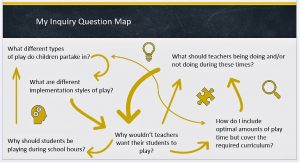
References & Resources:
Dietze, B. & Kashin, D. (2012). Playing and learning in early childhood education. Toronto: Pearson Canada. (available in the UBC Education Library)
Engel, M. (2015). The importance of free play in the early childhood classroom: Perspectives from a teacher. Childhood Education, 91(5), 323-324. doi:10.1080/00094056.2015.1090842
Fesseha, E., & Pyle, A. (2016). Conceptualising play-based learning from kindergarten teachers’ perspectives. International Journal of Early Years Education, 24(3), 361-377. doi:10.1080/09669760.2016.1174105
Pyle, A., & Bigelow, A. (2015). Play in kindergarten: An interview and observational study in three canadian classrooms. Early Childhood Education Journal, 43(5), 385-393. doi:10.1007/s10643-014-0666-1
The Canadian Association for Young Children. (November 2016). CAYC position paper on play. Retrieved from http://www.cayc.ca/sites/default/files/attachments/CAYC%20Position%20Paper%20on%20Play.pdf
Van Hoorn, J. et al. (2011). Play as the cornerstone of development. Ch. 3: The literature. (5th Ed.). Upper Saddle River, N.J. Pearson.
United Nations Human Rights Office of the High Commissioner. (1990). Conventions on the rights of the child. Retrieved from http://www.ohchr.org/EN/ProfessionalInterest/Pages/CRC.aspx
20 February 2017
Play, Imagination, and Creativity
- “make-believe play is essential to the development of the capacity for internal imagery” “It contributes to the development of creativity by opening children to experiences involving curiosity and the exploration of alternative situations and combinations.” (Van Hoorn et al., 2011, p. 61)
- Aspects of Imagination and Fantasy:
- “The accompanying ability to extend knowledge of characters, situations and events from the everyday into the realm of the improbable or impossible is a primary form of logic that encompasses ambiguity and paradox and merges thought and feelings. This ability to make meaning through narrative forms is one of the first examples of the ordering and classification of human experience.” (Van Hoorn et al., 2011, p. 62)
- The importance of binary opposites in creating dramatic tension play themes
Examples: love/hate, danger/rescue, the permissible/the forbidden, big/little, good guy/bad guy, death/rebirth, and lost/found - “These oppositional tensions help children discriminate features of their physical and social worlds and to define themselves within those worlds.” “children move flexibly between the sense and nonsense.” (Van Hoorn et al., 2011, p. 62)
- Sense of wonder, magic, and joy inherent in pretend play
- Logical thinking & negotiating meanings with others
- “The joy and wonder encompassed in imaginative play are powerful links to others and an incentive to self-regulation and perspective-taking.” (Van Hoorn et al., 2011, p. 63)
- Power of friendship
- Aspects of Imagination and Fantasy:

Play andSocial-Moral Development
- “learning to assert … rights … [and] learning to understand and accommodate the perspective of a third player” (Van Hoorn et al., 2011, p. 64)
- through play students can begin to assert their wants and needs in a less risky environment
- “Through social-moral dilemmas that involve reciprocal interactions with their playmates, children learn to make informed choices about their behavior and practice factoring in the perspectives of others” (Van Hoorn et al., 2011, p. 64)
- Moral Autonomy – characterized by being governed oneself “In a classroom that promotes moral autonomy, children construct beliefs about what is fair and unfair based on their experiences with their peers.” (Van Hoorn et al., 2011, p. 64);
- Moral Heteronomy – being governed by others
- Moral Autonomy – characterized by being governed oneself “In a classroom that promotes moral autonomy, children construct beliefs about what is fair and unfair based on their experiences with their peers.” (Van Hoorn et al., 2011, p. 64);
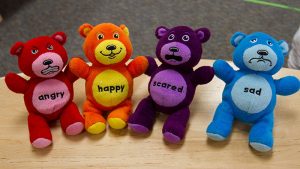
Play and Emotional Development
- “Children’s emotional development refers to their capacity to feel or experience a wide range of emotions such as happiness, sadness, anger, jealousy, excitement, wonder, and fear. Emotional development also involves children’s capacity to manage or regulate their emotions and their expression.” (Van Hoorn et al., 2011, p. 66)
- through play one can observe children work through their emotions as they can recreate previous scenarios and work through them in familiar settings
- “in play, children further develop their sense of purpose. In dramatic play, children enter into fantasies that allow them to explore their concepts of initiative and independence.” (Erikson) (Van Hoorn et al., 2011, p. 66)
- “[Piaget] described the ‘liquidating’ function of play that allows children to neutralize powerful emotions and release them by reliving them through make-believe. He also described the ‘compensatory’ nature of fantasy play that helps children rewrite events in which their feelings of helplessness or fear are overwhelming.” (Van Hoorn et al., 2011, p. 66-67).
- Interpersonal and Intrapersonal Intelligence: “characterized by the ability to accurately read and respond to the feelings, motivations, and desires of others and access one’s own feelings and sue them to guide behavior” (Van Hoorn et al., 2011, p. 67)
- Emotional Intelligence: “characterized by empathy and self-regulation” (Van Hoorn et al., 2011, p. 67)
Van Hoorn, J. et al. (2011). Play as the cornerstone of development. Ch. 3: The literature. (5th Ed.). Upper Saddle River, N.J. Pearson.
6 February 2017
Different Types of Play:
Onlooker Behavior – “when a child watches as others play, either because of reluctance to join, or as a way of scanning for an opening.” (Van Hoorn et al., 2011, p. 64) some onlookers will begin to imitate the play the are observing; some onlookers show interest in play or the behavior of others
Solitary Play – “defined as play alone, without overt interaction with peers” (Van Hoorn et al., 2011, p. 65) serves several different functions depending the age: provides context for dramatic play, provide a break from academic and/or the demands of others, and provide an opportunity for privacy (Van Hoorn et al., 2011, p. 65)
Parallel Play – “defined as play with shared materials or physical proximity without attempts to coordinate play” (Van Hoorn et al., 2011, p. 65) may involve non-verbal negotiations; is the beginning of group play
Group Play – two different forms: “associative play, is seen when children share and coordinate materials and space in proximity to one another, but lack true cooperation.” (Van Hoorn et al., 2011, p. 65); “cooperative play, involves sophisticated efforts to negotiate joint play themes and constructions with peers and it characterized by children stepping in and out of their play.” (Van Hoorn et al., 2011, p. 66)
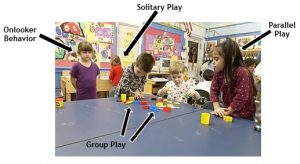
Van Hoorn, J. et al. (2011). Play as the cornerstone of development. Ch. 3: The literature. (5th Ed.). Upper Saddle River, N.J. Pearson.
30 January 2017
Teaching Team Conversations
- discussions of our inquiry questions help in expanding my view of my inquiry and allows us to learn as a group
- an interesting point was that some inquiry questions allow for classroom implementation (STEM or considerations for special needs children) while others are observation based (this is where my question falls)
- another consideration was consulting SA’s with our inquiry questions (some people have and some have not) naturally the more points of view provided can lead to multiple insights however I have hesitations when it comes to the timing of this interaction:
- too early – may lead to an influenced view of the topic and research may actually become narrowed
- at the end – may result in conflicting views
- to counteract both of these I think it is important to separate personal opinions from those of others while recognizing the value in what is being offered

Play and Logical-Mathematical Thinking
- helps students to develop spatial relationships, gravity, cause and effect, classify objects and basic addition and subtraction (Van Hoorn et al., 2011, p. 56)
- I have viewed these concepts when students are building with blocks and then proceeding to push it over
- during clean up times students are expressing their ability to classify the items by returning them to the containers they came from; this is also visible when students clean up puzzles
- helps students learn concepts of ‘more than,’ ‘less than,’ similar,’ and ‘different’ (Van Hoorn et al., 2011, p. 57)
- these concepts are visible as students often recognize if the person they are playing with/near has more of the material than they do (personal recognition of ‘less than’ and exterior recognition of ‘more than’
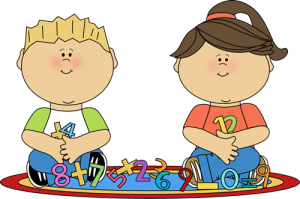
Play and Problem Solving
- when children play out scenarios they can play through ideas/problems and allow them to test out/experience consequences in a risk free environment
- IN-PLAY & OUT-PLAY:
- IN: “children enact roles and move the story line forward with action and dialogue”
- OUT: “children step out of make-believe roles to negotiate new roles, behavior appropriate to roles, and ideas for the plot of their play” (Van Hoorn et al., 2011, p. 59)
- visible during play times in the house and store (table with a cash register on top of it)
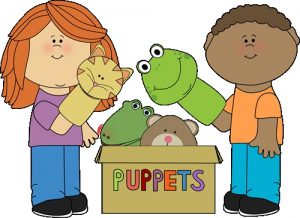
Van Hoorn, J. et al. (2011). Play as the cornerstone of development. Ch. 3: The literature. (5th Ed.). Upper Saddle River, N.J. Pearson.
23 January 2017
Play and Intellectual Development
- develops through Symbolic Thought which begins around 18 months; through symbolic play children can express ideas, feelings, and needs
- Symbolic Play with Objects: connects with Vygotsky’s “notion that concrete objects serve as pivots to ‘anchor’ children’s imagination and pretense” (Van Hoorn et al., 2011, p. 49); students’ play with objects leads to them becoming more familiarized which allows the object to become different items, for example blocks becoming cars
- Symbolic Role Play: “as children’s capacities for representing ideas develop, they increasingly create pretend roles and situations without the use of costumes or props, using more subtle behaviours such as gesture and intonation to mark their transformation into make-believe roles in play” (Van Hoorn et al., 2011, p. 49). playing out sceneros which are familiar to students help them adjust to new surroundings; this is especially helpful for English Language Learners to easily integrate into a recognizable situation providing opportunities to practice and expand upon language development
- Symbolic Play with Objects and Symbolic Role Play both help develop abstract thinking in children/students
Play and the Development of Language and Literacy
- “Children’s exploration of sounds, arrangements of words, and meanings of words form the context for children to invent unique forms of language and to master new forms as they are acquired.” (Van Hoorn et al., 2011, p.54) students are given the opportunity to practice their language during play as the emphasis is on listening and speaking sounds
- Literacy in Play: Decoding Symbols: understanding/becoming familiar with the social functions of print; helps students learn Symbolic Transformations the understanding that letters and numbers are made up of lines can be seen in play when a block is used to make a building, used as a car and used as pretend food; it is also important to recognize the opposite: all of these different items can be produced through one item; we see these transformations when students learn concepts which are often bewildering: ‘S’ sound in city, ‘K’ sound in cake and later with combining two lines to make something different: ‘TH’ for thanks and ‘CH’ for choo choo
- The Development of Narrative: “Taking on the roles of different characters and sequencing events to tell a story form the foundation for the important aspect of literacy learning called ‘narrative’” (Van Hoorn et al., 2011, p. 56). Students who build narratives understand that characters, motives, and plots ares sequential and based on each other

Van Hoorn, J. et al. (2011). Play as the cornerstone of development. Ch. 3: The literature. (5th Ed.). Upper Saddle River, N.J. Pearson.
16 January 2017
My inquiry question has developed from observing the play times in the kindergarten classroom. I know these times are important for the students to learn and develop but I am unsure of how and what they are learning.
Inquiry question development:
- What is the role of the teacher during play times? I find myself observing students but I am unsure and unclear exactly what it is I am looking at. Furthermore, I understand that the students are learning while they are playing yet I am unsure what it is they are learning.
- How are play-based activities incorporated into the classroom?
- What are primary children learning during play times?
Now that I have had several visits in the classroom I have begun to notice students who are playing at one station, changing play areas, or wandering seemingly unable to select something/one to play with during the designated play times. I have also started to recognize students who are drawn to the same activities each play time, those that are often participating in solitary play and students who are often playing together.
In Class
Into the Story Activity
Benefits of integrating students into the story rather than simply reading the story are:
- provides a deeper meaning
- builds a stronger connection to the story
- allows students to take on a different role (put themselves in someone else’s shoes)
- requires involvement which avoids students from zoning out or doing something other than listening
- appeals to a variety of different learning styles
The story we used for this exercise was about a boy who really wants a pair of shoes that the majority of his classmates own. For our into the story we designed our own shoe, created a tableau and participated in a conscious alley activity.

The shoe I designed for an 8-13 year old.
I enjoyed these activities as they brought the story to life and helped to build a stronger connection to the story. Listening and relating to a story can only extend so far while placing students in the story enhances the story and expands the message of the story.
